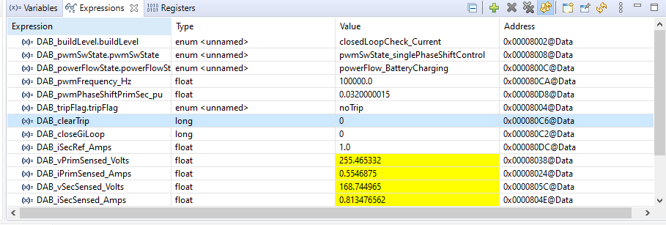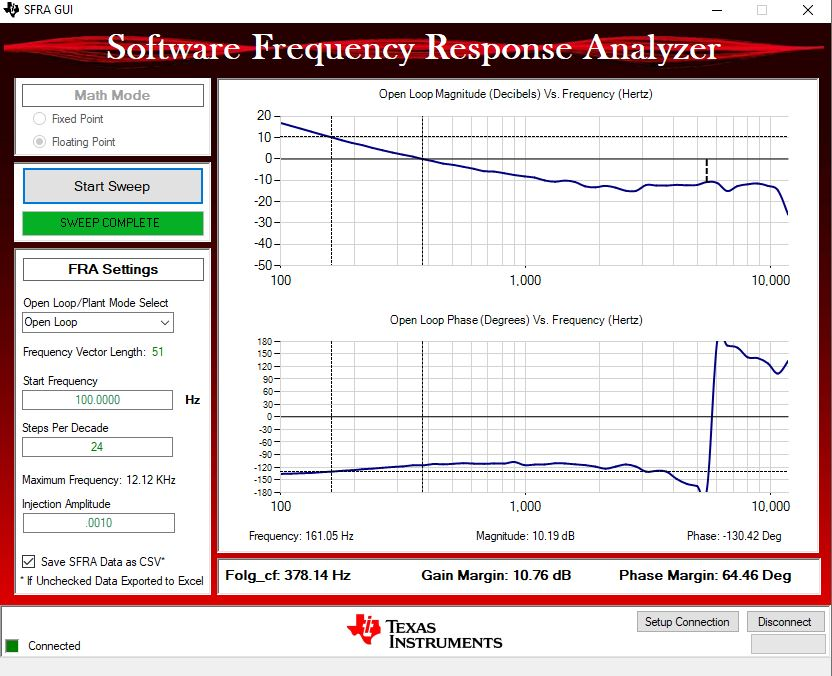JAJU732C June 2019 – July 2022
- 概要
- Resources
- 特長
- アプリケーション
- 5
- 1System Description
- 2System Overview
- 3Circuit Description
- 4Hardware, Software, Testing Requirements, and Test Results
- 5Design Files
- 6Related Documentation
- 7Terminology
- 8About the Author
- 9Revision History
4.4.4 Lab 4
- Test Setup for Lab 4 (Closed Current Loop -
Isec)
Compile the project by selecting Lab 4: Closed Loop Current with Resistive Load in the drop-down menu of Project Options from PowerSUITE GUI. Ensure current/voltage limits are set per operating conditions.
#if DAB_LAB == 4 #define DAB_CONTROL_RUNNING_ON C28X_CORE #define DAB_POWER_FLOW DAB_POWER_FLOW_PRIM_SEC #define DAB_INCR_BUILD DAB_CLOSED_LOOP_BUILD #define DAB_TEST_SETUP DAB_TEST_SETUP_RES_LOAD #define DAB_PROTECTION DAB_PROTECTION_ENABLED #define DAB_CONTROL_MODE DAB_CURRENT_MODE #define DAB_SFRA_TYPE 1 #define DAB_SFRA_AMPLITUDE (float32_t)DAB_SFRA_INJECTION_AMPLITUDE_LEVEL1 #endif- Run the project by clicking green run button in CCS
- Populate the required
variables in the watch window by loading javascript '
setupdebugenv_lab4.js' in the scripting console
 Figure 4-37 Lab 4 Watch
View Configuration
Figure 4-37 Lab 4 Watch
View Configuration - Enable PWM by writing “1” to the DAB_clearTrip variable
- In the watch view, check if the DAB_vPrimSensed_Volts, DAB_iPrimSensed_Amps, DAB_vSecSensed_Volts, and DAB_iSecSensed_Amps variables are updating periodically
- Set the output current by writing to DAB_iSecRef_Amps (in this example 1Adc)
- Enable closed loop
operation by writing “1” to the DAB_closeGiLoop variable. The controller
automatically adjusts the phase shift from default 0.032 to 0.04186
depending upon the operating conditions to generate secondary output
current to match with that of DAB_iSecRef_Amps. Note: In the software the maximum phase shift is limited to 0.065 as a safety precaution. Please adjust the primary voltage to stay within the phase shift limits and still generate the required secondary current. Alternatively the maximum allowed phase shift can be modified to 0.15 in the code.
 Figure 4-38 Lab 4 Watch
View - Enable Closed Loop
Figure 4-38 Lab 4 Watch
View - Enable Closed Loop - Now, slowly increase the
input VPRIM DC voltage and adjust DAB_iSecRef_Amps accordingly to reach
to the required operating point. Note: Ensure to limit the secondary current is limited to a safe value depending upon the output load. High impedance load can lead to dangerous secondary voltage which can destroy the board. Make sure secondary over voltage protection is enabled and the threshold is set to safe value.
#define DAB_PROTECTION DAB_PROTECTION_ENABLED #define DAB_VSEC_TRIP_LIMIT ((float32_t)500) #define DAB_BOARD_PROTECTION_VSEC_OVERVOLTAGE 1
- Frequency response of closed loop current
- Run the SFRA by clicking on the SFRA icon. The SFRA GUI will pop up.
- Select the options for the device on the SFRA GUI; for example, for F280049, select floating point. Click the Setup Connection button. In the pop-up window, uncheck the boot-on-connect option and select an appropriate COM port. Select the OK button. Return to the SFRA GUI and click Connect.
- The SFRA GUI will connect to the device. A SFRA sweep can now be started by clicking “Start Sweep”. The complete SFRA sweep will take a few minutes to finish. Monitor the activity in the progress bar on the SFRA GUI or by checking the flashing blue LED on the back of the control card, which indicates UART activity.
The plot in Figure 4-39 is captured with the PI compensator (gain of 6).
 Test condition: VIN = 600 V, IOUT = 4.2 A, VOUT = 440 VFigure 4-39 Lab 4 SFRA Open Loop Plot for the Closed Current Loop
Test condition: VIN = 600 V, IOUT = 4.2 A, VOUT = 440 VFigure 4-39 Lab 4 SFRA Open Loop Plot for the Closed Current LoopCurrent is sensed by AMC3301 at battery(load) side. PI Controller information follows:
#define DAB_GI_KP 6 #define DAB_GI_KI 0.0063030 #define DAB_GI_UMAX 0.06 #define DAB_GI_UMIN 0.001 #define DAB_GI_IMAX 2.0 #define DAB_GI_IMIN ((float32_t) - 2.0)